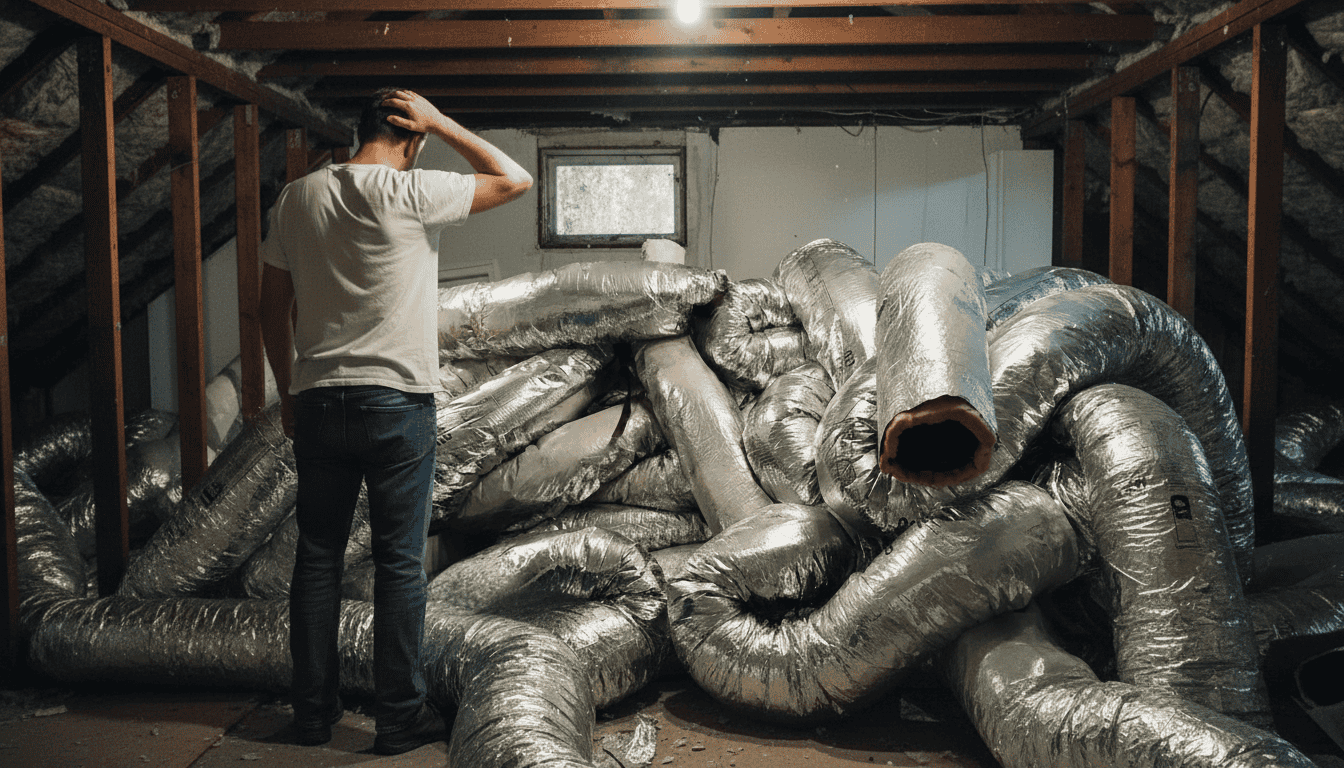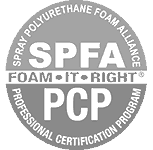There is so much to be said for these competing products in many applications. Spray polyurethane foam of both primary types, open-cell foam, and closed-cell foam, is still compared to fiberglass and vice versa in so many applications. Differences in performance, R-value, moisture qualities, pricing, effects on the environment, blah blah, etc., have always been commonplace conversations—sometimes nasty fights.
But this may be one of the first attempts on the internet to compare the performance of each material as it pertains to rigid metal ductwork under the home or in the crawlspace.
Ductwork. Possibly the most under-appreciated component of your home
Ducts in the crawl space deserve so much more attention than the typical contractor in the HVAC industry gives them. In general, residential HVAC industry sales goals are based on replacing old, dreary-looking heavy metal boxes with newly pristine, shiny, bigger, and even heavier boxes. Meaning, new AC condenser units and air-handlers/furnaces are what we have been trained to believe is the fix-all to energy efficiency, comfort, moisture concerns, and monthly bills. While paying attention to ductwork, especially under the house, is, at best, usually the afterthought, and only if there’s money left in the budget to give it some attention. This is also consumer-driven as we believe that replace and run is much easier and quicker and gets the job done just the same when we want warmth or cooling, and NOW!
Download The DOE Duct Fact Sheet
Yet, the energy efficiency of your house, the size of your monthly utility bill, the overall comfort of your home, and indeed its level of indoor air quality can be very dependent on the condition of the crawlspace ductwork—more so than the typical industry representative lets on. They are round tubes. Just how vital can ductwork be?
Of course, when we need a system replacement, we quickly need a replacement! It broke down. Costly monthly freon leaks are more than financing a new one. It’s loud and clunky. It’s old. It’s keeping up with the Jones’. It’s just time to retire it to the landfill.
Download The Energy Star Duct Fact Sheet
The HVAC Bling Bling Affect
When we hear or think “HVAC system,” the average consumer doesn’t visualize repairing and improving the dusty and tangled distribution component of the system “as a whole” – its veins and arteries of its overall performance – but, instead, installing what looks like heavy, sturdy, quality, and sometimes shiny boxes come to mind. We perceive quality in weight. And we all like shiny things. However, these expensive boxes cannot even come close to achieving their efficiency ratings (SEER, EER, AFUE), if the ductwork is shown no love.
It’s scary down there!
Unlike ductwork that is protected within the home’s living space or even, to a lesser extent, inside a hot-vented attic, ductwork under the house is bombarded by not only the typical outdoor elements but even more so by the Gulf South has to offer. Our extreme humidity is one of the most telling of these harsh ambient conditions. Along with the possums, all outdoor conditions strain building materials, decreasing their lifespans considerably. But, specifically, humidity is our harshest culprit.
How long does fiberglass insulation last?
Fiberglass insulation can achieve its manufacturer-self-proclaimed R-value only if it is not exposed to ambient conditions. The moment airflow and moisture are introduced to the material, its given R-value, and therefore performance, sinks not only by fractions but hard whole numbers.
The R-Value Fairy in effect
Here enters fiberglass. Hopefully, the fiberglass around the ductwork will be wrapped tightly and stapled into place around what we’d like to assume are perfectly air-sealed joints, seams, and connections throughout a hundred or more linear feet of cylindrical metal tubing.
However, tapes and adhesives, especially from years ago, have limited lifespans, like any other building materials. But they wear down even faster outside than inside, as do other building materials. Regardless of whether they are stated or assumed to be “outdoor approved,” the fact is that they lose their effectiveness. Although high moisture content in the air is good for hydrating your skin and keeping you younger over a more extended period of time, this same moisture is rough on building materials.
With the help of airflow, there goes the performance of the pink stuff even faster. Once the upwards of 100% relative humidity in the crawlspace seeps its way into even the smallest and tightest of seems within the ductwork fiberglass wrapping, deterioration increases. Then goes the performance of the overall system. The condensation that forms on the cold metal piping under the wrapped, stapled, and taped fiberglass begets more condensation. The deterioration then exponentially increases. The performance, therefore, exponentially decreases.
Even Before Installation, It Lacks Its Perceived Integrity
Fiberglass insulation, in any form in any application, is immediately compromised the moment we slice the vacuum-sealed encapsulation open and pull it apart. It is compromised even more once we push it into a cavity of any width, length, depth, and altitude. But it’s even worse when installed outside of an enclosed conditioned space.
BUT! Whether it be due to ignorance or intentional avoidance. If it is not encouraged to be discussed—or worse, encouraged against discussing during a box sale—the importance of adequately insulated and sealed ductwork, especially under the home, always remains a top priority. While we are joyously smiling as our bank runs our credit so we can take out a second mortgage on a new replacement system, consider the “whole” of the system to ensure you achieve the maximum and multiple gains.
It Is Time To Get With The Times
Fiberglass is not supposed to go outside. It’s really that simple. It never was. It isn’t now. But it’s what we had “back in our day” when My Three Sons and Archie Bunker were the Hollywood hits. Back in “that” day, we didn’t know what we should know. Installing an interior building material outside the home’s envelope in some of the worst conditions was what we did. However, we now know better. It’s time to move on. Building Science and Industry Best Practices has been at the forefront of residential construction worldwide for years. Unfortunately, as is often the case with many technology and informational advances, geographically, down here in the greater New Orleans and the Gulf South region, we have remained behind the Building Science knowledge curve for years. And, well, more than that in practice.
We’re Glad You Asked!
“So, if fiberglass is not supposed to go outside. If moisture breaks down the insulation’s R-value. If airflow reduces its performance. If deteriorating adhesives cause air loss and additional condensation on the metal ducting. If that initial condensation decreases the insulation’s and adhesives’ performance even more which, again, causes even more condensation and energy loss. If the rats, bunnies, cats, possums, fleas, and squirrels easily and enjoyably rip it apart and set up shelter in and around it, causing even more deterioration, condensation, and energy loss, eventually leading to rust. What is the alternative?”
Download The FEMA Flood Damage-Resistant Materials PDF
The Solution To Achieving Savings And Product Sustainability
We would need a product that is a vapor barrier and an air barrier. It would be great if this insulating material consistently maintained its same high R-value, unhindered by ambient conditions. Speaking of crawlspace critters, locating an insulation with a high density and tight uniformity that does not provide favorable living conditions for them.
The correct exterior-rated polyurethane spray foam, applied appropriately under properly prepped conditions, meets the above standards and additional ones to be discussed.
Big, heavy metal units are lovely. We want them. We need them. They naturally require replacement in time, and we pay dearly for them. However, before spending tens of thousands of dollars on them, it may be worth having Diversified Energy enhance the overall system’s performance to maximize your monthly energy savings, the quality of your home’s indoor air, and the life of the existing rigid metal ductwork, which itself can far outweigh the cost of those shiny boxes.
Polyurethane foam is not always the solution. Sometimes, the installation of fiberglass and spray foam yields the same effect. Sometimes, the bang for the buck or the return on investment does not warrant what may be a higher initial investment for polyurethane foam. At other times, fiberglass may be the preferred option for a particular application. However, fiberglass duct wrap loses this fight when it comes to rigid metal ductwork in an open crawlspace.



















